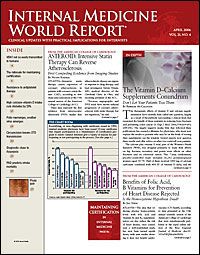Publication
Article
New AHA Dietary Recommendations to Prevent/Treat Hypertension The Epidemic of High BP Can and Should Be Prevented
Author(s):
Simple dietary modifications that lower blood pressure (BP) may prevent hypertension and reduce the risks of BP-related complications in both normotensive persons and those with prehypertension, according to a scientific statement recently issued by the American Heart Association (AHA) (Hypertension. 2006;47:296-308).
Examples of diet-related lifestyle modifications that lower BP include weight loss, reduced in?take of salt and increased intake of potassium, moder?ation of alcohol intake, and following the DASH (Diet?ary Ap?proach??es to Stop Hyper?tension) diet (Table).
"High blood pressure remains an epidemic in the United States, but it can be prevented," said lead author Lawrence Appel, MD, of the Johns Hopkins University School of Medicine, Baltimore. "By improving their diet, people can reduce their blood pressure and put a major dent in their risk of cardiovascular disease, including stroke, coronary heart disease, and heart failure."
By improving their diet, people can reduce their blood pressure and put a major
dent in their risk of cardiovascular disease."
? Lawrence Appel, MD
The report highlights a growing body of clinical and research evidence suggesting that dietary changes can serve as initial treatment before starting drug therapy in patients with uncomplicated stage 1 hypertension (systolic BP of 140-159 mm Hg or diastolic BP of 90-99 mm Hg). Dietary changes, particularly reduced salt intake, can also decrease BP and facilitate step-down therapy in patients taking antihypertensive drugs.
"The current challenge to health care providers, re?search?ers, government ?offi?cials, and the general public is developing and implementing effective clin?ical and public health strategies that lead to ?sustained dietary changes among individuals and, more broadly, among populations," according to the authors of the report.
The increasing prevalence of overweight and obesity in the United States and the direct relationship between weight and BP underscores the importance of weight loss in the treatment and prevention of hypertension.
The report notes that BP levels fall before, and without, achieving ideal body weight and that a modest weight loss can lower the risk of hypertension by about 20% in overweight individuals with prehypertension.
BP increases proportionally with dietary salt intake, and sodium restriction can decrease the risk of hypertension by about 20%, lower BP in persons taking antihypertensive medications, and inhibit age-related increases in systolic BP, the guidelines state. With >75% of consumed salt coming from processed foods, the writing committee called upon food manufacturers and restaurants to reduce the amount of salt added to foods by 50% over the next 10 years.
Key points
High BP remains an epidemic in the United States.
Dietary changes can decrease BP and facilitate antihypertensive medication step-down therapy.
Salt intake should be limited to 1.5 g/day.
Dietary potassium intake should be increased to 4.7 g/day.
Daily alcohol intake should not exceed 2 drinks for men and 1 drink for women.
Physicians should educate their patients about these measures.
The AHA report notes that consuming >2 alcoholic beverages per day increases BP, regardless of age, obesity, salt intake, and other potential confounders. Some studies have shown that this relationship also extends to the light alcohol intake range ( 2 drinks/day), but such intake has also been associated with a decreased risk of coronary heart disease.
BP is inversely related to dietary potassium, and increased potassium intake has a greater BP-lowering effect in the context of higher salt intake. The AHA recommends consuming more potassium-rich foods, such as fruits and vegetables, rather than taking potassium supplements, consistent with the DASH dietary criteria.
The DASH diet emphasizes increased consumption of fruits, vegetables, whole grains, low-fat dairy products, poultry, and fish, and decreased consumption of fats, red meats, sweets, and sugar-containing beverages. This diet has been shown to significantly lower systolic and diastolic BP in all major patient subgroups when compared with control diets. It is also safe and broadly applicable to the general population.
"Individualized physician-directed lifestyle advice should be based on the patient's willingness to adopt lifestyle changes," the AHA report states. "Moti?vated patients should be referred to a skilled dietitian, health educator, or behavioral change program, in large part because success relies on frequent follow-up."
The guidelines are available at www.americanheart.org.






